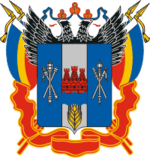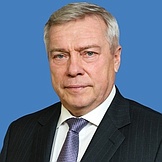Regional flags and emblems


PROFILE
Established 13 September 1937
Capital Rostov-on-Don
The Rostov Region is part of the Southern Federal District
Area 101,000 sq km
Population 4 135 000 (2025)
Ethnic groups
(2020 National Census, %)
Russian – 91,69
Armenian – 2,19
Turk – 1,03
Other – 5,09
Administrative divisions (2024)
Municipal districts – 43
City districts – 12
Rural towns – 17
Rural districts – 391
Geography and climate
The Rostov Region is in the southern East European Plain.
The region borders on several Russian entities – the Republic of Kalmykia, the Lugansk People’s Republic, the Donetsk People’s Republic, the Krasnodar and Stavropol territories, and the Volgograd and Voronezh regions.
It also has a coastline along the Taganrog Bay on the Sea of Azov in the southwest.
The Rostov Region is located in the steppe zone. One of Europe’s largest rivers, the Don River, flows through the region. It is connected with the Volga River by a canal, creating a united river transportation system in the European part of Russia. The Volga-Don canal’s hydro-technical facilities serve as a basis for the water management system in the region, and include one of the largest reservoirs in the region – the Tsymlyanskoye water reservoir.
The region has a favourable, moderate continental climate. January temperatures average –3.8°C. July temperatures average 25.3°C.
The region is agglomeration of specially protected natural areas: the Rostov state biosphere reserve and Tsymlyansky state nature sanctuary, three public regional nature sanctuaries, three regional protected areas, 61 natural landmarks, 8 protected sites and Southern Federal University`s Botanical Garden.
Government
The legislative branch is the Legislative Assembly of the Rostov Region, which is the permanent, representative and only body of legislative authority in the region.
The Legislative Assembly of the Rostov Region consists of 60 deputies elected for five years, with 40 of them running in single-number constituencies and the other 20 in the single electoral district in proportion to the number of votes cast for lists of candidates nominated by electoral associations.
The current Legislative Assembly of the Rostov Region was elected in September 2023. Its term expires in September 2028.
The executive branch in the Rostov Region is represented by the Governor of the Rostov Region, the Government of the Rostov Region and other executive agencies of the region. The Government of the Rostov Region is the supreme and permanent executive body in the region.
The Governor of the Rostov Region is the region’s highest-ranking official, who exercises the executive authority in the region, forms and heads Government of the Rostov Region. The Governor is elected for five years by Russian citizens who permanently reside in the region. The term of office of the Acting Governor – until the person elected Governor of the Rostov Region takes office
Economy and natural resources
The Rostov Region has one of the largest and most diverse industries in the southern part of Russia with highly developed agriculture, science and culture.
Industry accounts about 30% of regional GDP.
Manufacturing, production and distribution of electricity, natural gas and water, and mineral extraction account for the largest share of industrial production of the region.
The leading types of manufacturing are machine-building sector (Rostselmash, AEM-Technologies subsidiary, Atommash, and Novocherkassk Electric Locomotive Plant), metallurgical production (Tagmet, Rostov Electrometallurgical Plant, Novocherkassk Electrode Plant and Klever) and food production. The Rostov Region has a range of high-tech industries including helicopter manufacturing (Rostvertol).
The production and distribution of electricity, natural gas and water is carried out by the Rostov Nuclear Power Plant (subsidiary of Rosenergoatom), hydroelectric power plants, thermal power plants and combined heat and power plants (Tsimlyanskaya Hydroelectric Power Plant, Novocherkasskaya Thermal Power Plant, Volgodonskaya, Kamenskaya and Rostovskaya thermal power plants, Shakhtinskaya Gas Turbine Power Plant). The region is 85 % gasified.
The Rostov Region is an energy-surplus region. This gives it a significant competitive advantage in attracting investors in new power-consuming industries.
The region has a developed transport infrastructure: it has railways and federal motorways, Platov Rostov-on-Don International Airport and regional Taganrog Yuzhny Airport. The region has three Sea ports (Rostov, Azov and Taganrog sea ports), two river ports (Volgodon river port and Ust-Donetsk river port). The transport industry accounts for about 10% of the regional GDP; it has consistent upward trends in increased cargo traffic through the region.
The Rostov Region is one of the largest producers of agricultural products in the Russian Federation. The production of agricultural products is dominated by the production of grain crops (autumn wheat, spring barley), grain legumes, gourds and oil crops (sunflower), as well as corn, millet, rice, buckwheat, pea and soy. The soils are favourable for viniculture combined with gardening. Livestock farming focuses on meat and dairy cattle breeding, pig breeding, sheep breeding, horse breeding and poultry farming. The region’s fishing industry is also highly developed.
Culture and tourism
The region’s main tourist brand Silver Horse Shoe of the Don tourist route offers educational, environmental, ethnographic, rural, and other tours. The “quiet-flowing” Don is the cradle of a special ethnic community, the Don Cossacks, with their own way of life and historical traditions.
State museum-reserves hosting colorful annual holidays and festivals have been set up in the birth places of famous Russian writers Anton Chekhov and Mikhail Sholokhov.
The region has many archeological federal landmarks, including the Tanais Archaeological Museum-Reserve, the ancient settlement of Nizhne-Gnilovskoye, fragments of the 14th century Genoese Fortress, and a number of burial mounds and necropolises.
Local museums possess unique collections of gold items dating back to the Scythian-Sarmatian period that show the ethnic and cultural diversity of the region, plus Cossack household items and works by well-known painters from the 18th-20th centuries.


